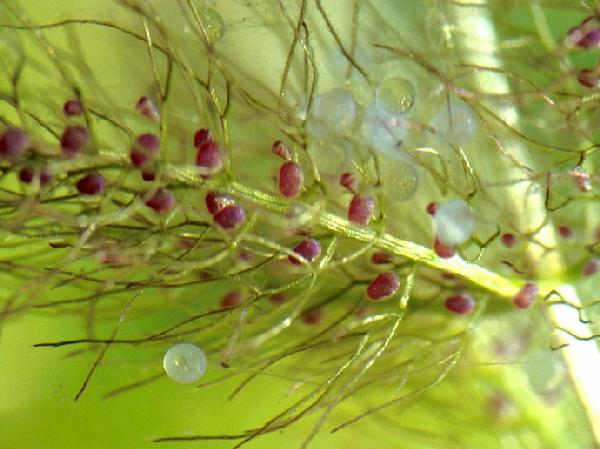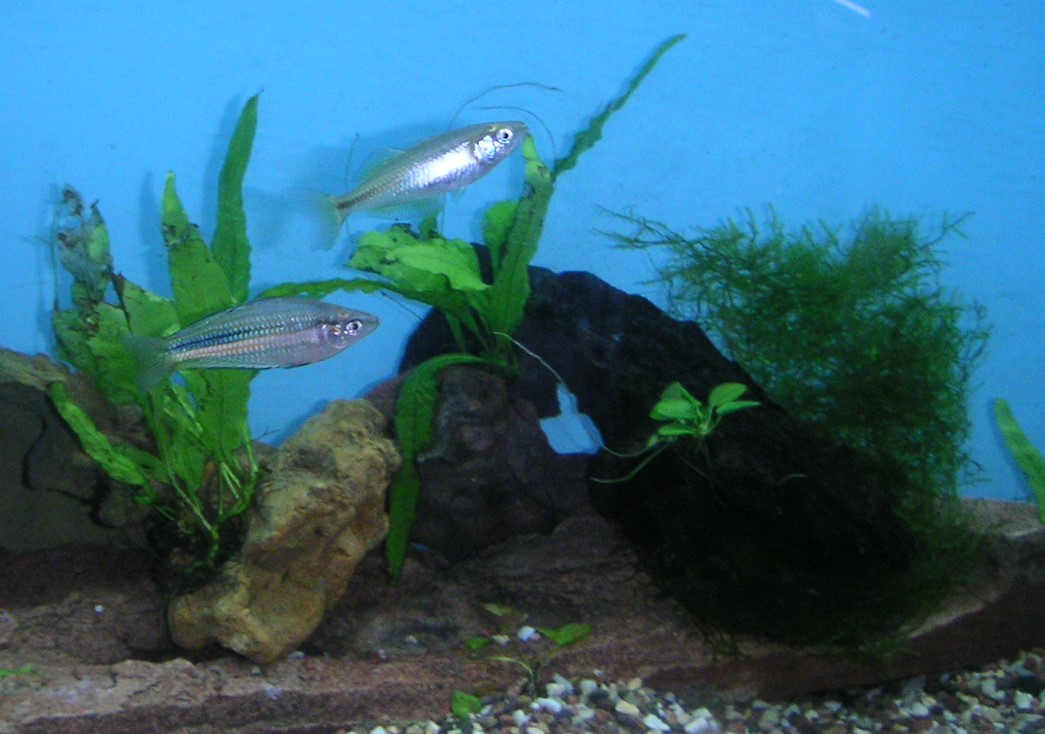| BREEDING AND RAISING RAINBOWFISH Actually, I leave the breeding to the fish, as they seem to pair off in my tank and spawn regularly. My part is in retrieving the spawn then hatching and raising the fry. If left in the spawning tank, eggs and any fry that hatch will be eaten. Raising the fry is the hard part, as they require plankton such as rotifers and algae and other types of microscopic foods. Unless you are retrieving an incidental (unplanned) spawning, the first step is to ensure that a supply of live foods in ready for when needed. "Infusoria" and "green water" cultures containing micro-organisms such as Euglena and Paramecium, that make ideal foods for fish fry. I have used Spirulina powder and prepared liquid foods for fish fry, to supplement the initial live foods. Paragon's "Liqui-Fresh #1" is good for this job and to feed those unplanned fry. I have used Java Moss as a spawning medium in my tanks
but any, fine-leaved, aquatic plant will do as well. as long as there is a
mass into which the fish can scatter their eggs. However, I would not use
Utricularia, as shown below (picture by Günther Schmida, of
rainbowfish eggs on Utricularia gibba.) Utricularia has
carnivorous traps (the brown sacs in the picture) that may devour small fry!
Rainbowfish eggs are very small and pin-head sized spheres, with a relatively hard "shell". Once the plant mass contains eggs, I remove the entire mass of Java Moss, with eggs attached, and place it in a small tank to act as a hatchery. The water is well aged and ammonia and nitrite free, and at the same temperature, pH and alkalinity as the spawning tank. Water temperature is kept at the same range as for keeping the adults, at 20-27o C. Hatching takes place in about a week (6-9 days). The newly hatched larvae remain attached to the spawning medium until their yolk sacs have been absorbed, before becoming free-swimming fry and move to the surface layers of the water, close to the top. It is time to begin feeding routines when the baby fish gather at the surface and start looking for food. In my fish-house I maintain a culture of plankton which serves as first food source. Once swimmers appear I use an eye-dropper to add "green water" directly to the surface, three or four times a day. Spirulina powder and prepared, liquid foods for fish fry supplement the live foods. After two weeks, powdered fish foods are accepted. I use a very fine powdered fish food from this stage onwards, with daily additions of "green water". Later, larger foods, such as micro-worms and brine shrimp nauplii are fed when the fish are large enough to swallow them. |
| MORE
DETAILED NOTES ON BREEDING RAINBOWS Prepare the food cultures:
"Infusoria" is a term that is used to refer to micro-organisms such as Euglena and Paramecium that grow rapidly when pond water is infused with rotting leaves, such as lettuce or hay straw. Fill a small container with pond water or water siphoned from the bottom of an established aquarium and add a handful of pesticide free, soft lettuce leaves and/or hay straw to it and let it stand for several days. Adding green water from a pond or tank will help the culture develop- but also risks adding unwanted organisms from the pond. As the leaves rot, micro-organisms develop in the water in large numbers, feeding on the decomposing leaves. These can be seen with a low powered microscope- a micro-zoo in a tub! A turkey-baster or large eye-dropper is best used to remove the culture to feed to the tiny Rainbowfish fry during the first days that they are seen free swimming at the surface. Micro-worms are tiny worms that are easily cultured in a mix of "Easy Oats" or rolled oats mixed with boiled water to a thick, creamy consistency to which a little bakers yeast is added for fermentation. Cultures of Micro-worms are usually available from Pet Shops. Prepare the fish for spawning by feeding them well with live foods such as brine shrimp, black worms, blood worms and mosquito larvae. Frozen foods are acceptable for this, too. When ready to breed, females will be plump. The fish may also display and show other signs of being ready to spawn, as they chase and dart among the plants. Partial, water changes may trigger spawning and, in my native Australia, water temperature is not a critical factor, except for tropical, New Guinea species of Rainbow. Adjust the water temperature if needed, to an optimum temperature of 24-28°C., for spawning, hatching, and rearing rainbowfish, species. The range for breeding Melanotaenia fluviatilis can be 20oC - 24oC. I have had them spawn at 19oC. It is assumed that water parameters are ammonia/ammonium and nitrite free, low in nitrates, well oxygenated and of the correct pH and dH for the species. For example, M. praecox requires soft, acidic to neutral water and M. boesmani and most Australian species require harder water and a higher pH. [See my Australian Rainbows and New Guinea Rainbows for some details of selected species.] Prepare and select the fish by feeding both them a balanced diet, including live-foods, to condition then prior to mating and observe behaviours. Select pairs that can be seen isolating themselves from the shoal or place a trio in the tank (one male, two females). Getting Rainbows to spawn presents
few problems. Add any spawning medium that you are going to use.
Spawning mops are just as good and are made from cotton, wool or nylon fibres. Spawning usually take place early in the morning. The fish swim around the spawning medium and chase each other, eventually the females scatter their eggs in the spawning medium and the male follows with his milt release. As Rainbows are scatterers and non-guarders, they show no further interest in their eggs- except that other fish and hungry parents may eat eggs and larvae. After spawning is complete, remove the fish to their holding tank or remove the spawning medium to a hatchery tank or shallow tray. Some breeders use shallow trays to as hatcheries. I have not tried that method but information is available from Adrian R. Tappin and Gary Lange. Hatching takes place in about a week. |
|
HATCHING
The fertilized eggs will hatch in about a week (6-9 days). Low light levels are better than intense light at this stage. The fry are very tiny and stay attached to the spawning medium. During this stage the fry live on their egg sacks and do not require feeding. This is a good time to remove any unhatched, diseased eggs and to check the infusoria culture. In about 2-3 days from hatching, the fry will begin to be free swimming. Begin feeding the active, free swimming fry, as they begin to forage about the tank eating micro-organisms. Feeding the fry on rotifers, "infusoria" or prepared mixtures of liquid fish food and Spirulina powder is a good start. |
|
RAISING THE TINY FRY is the hard part! Unless
live food
is given, most fry starve to death when their eggs sacks are
depleted. Some breeders find that leaving the lights on all the time assists fry
development. I can't afford that, so they do with what falls. FEEDING is critical:
Feed infusoria and newly hatched brine shrimp from the start of the free swimming stage. Liquid fish food can be used at this stage, too. I have had success with Paragon's "Liqui-Fresh #1" as a first feeding substitute for live foods. I use it in conjunction with infusoria and pre-mix it in a small container and add it to the tank with an eye-dropper every two hours. Similar prepared-foods for baby fish may be tried. Frequent feeding is necessary in small amounts and up to ten times a day. Be careful not to over feed and sour the water. Removing uneaten food is very difficult at this stage, as the tiny fry may be siphoned out as well. Using a "turkey baster" or a large eye-dropper is helpful. Never allow uneaten foods to collect in the tank. The young fry may be raised in tanks fitted with a
mature sponge filter. Run the air flow at a very, gentle rate so as not to
kill them with too much surface movement of water. The fry will be seen
picking at the surface of plants, the glass and the filter sponge
(if one is present), taking the micro-organisms on those surfaces. When large enough to swallow the food, give baby brine shrimp, small copepods and micro-worms to enable a high survival rate. Growth rates will depend on local conditions and feeding. Good luck with breeding your favourite Rainbows. |
| LINKS
to two articles on raising Rainbowfish.
Adrian R. Tappin, has informative pages on Breeding and Raising Rainbowfish Fry. Gary Lange tells how easy he finds the breeding and raising of Rainbows.
GOOD LUCK WITH YOUR RAINBOWS
|
 When Java Moss is not
available, artificial spawning mops are a good substitute for natural
materials and can be purchased either from specialty shops ready made or
made yourself from new, floor mops. Buy a cotton mop- one without
any impregnation of fungicides or other disinfectants- remove any metal
parts, unravel the fibres, wash them in clean, dechloraminated water and
suspend them in the tank on inert, nylon ties or fine rope. A 30cm long
bundle of undyed (or even dye-fast) woollen or nylon yarn does as well.
Tie it to make a fibrous mass into which the fish can spawn. Using a dark
colour makes it easier to see the eggs.
When Java Moss is not
available, artificial spawning mops are a good substitute for natural
materials and can be purchased either from specialty shops ready made or
made yourself from new, floor mops. Buy a cotton mop- one without
any impregnation of fungicides or other disinfectants- remove any metal
parts, unravel the fibres, wash them in clean, dechloraminated water and
suspend them in the tank on inert, nylon ties or fine rope. A 30cm long
bundle of undyed (or even dye-fast) woollen or nylon yarn does as well.
Tie it to make a fibrous mass into which the fish can spawn. Using a dark
colour makes it easier to see the eggs. I
use Java Moss. Pictured right are two M. fluviatilis (female at
top). The male is showing a darker, lateral-line stripe than usual and the
full-body of the female is noticeable. This pair spawned and I removed the
Java Moss to hatch the eggs in another tank. This was not a planned
mating, otherwise the mass of Java Moss would be far larger. The other
plants are Java Fern, Dwarf Anubias and a small lily. Sometimes the fish
spawn in the Java Fern.
I
use Java Moss. Pictured right are two M. fluviatilis (female at
top). The male is showing a darker, lateral-line stripe than usual and the
full-body of the female is noticeable. This pair spawned and I removed the
Java Moss to hatch the eggs in another tank. This was not a planned
mating, otherwise the mass of Java Moss would be far larger. The other
plants are Java Fern, Dwarf Anubias and a small lily. Sometimes the fish
spawn in the Java Fern.